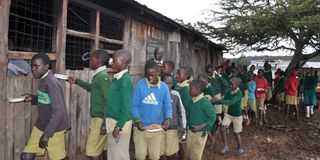Farmers cash in on school feeding project

Pupils of Chumvi Primary School in Laikipia County have their lunch, which is provided under the school feeding programme. PHOTO | ERIC WAMANJI |
What you need to know:
- Joseph Maina is among farmers in the region who are reaping big rewards from the school feeding programme.
- The farmers grow maize and sell to schools under the government-run programme.
Joseph Maina strolls in his five-acre maize plantation in Kalalu, Laikipia.
“I expect good harvest; better than last year,” he breaks the long silence excitedly.
This thrill is understandable for him and farmers in the region. So lucrative is the cereals’ market that demand outstrips production.
“For long, traders used to exploit farmers. They dictated prices and even adulterated the weighing scales.”
The brokers would buy a 90kg bag of maize from Sh1,800 to Sh2,000 depending on the season.
But that is in the past. Farmers joined hands to form the Mount Kenya Producers Market Organisation (PMO) through which they sell their produce.
“Members deliver their produce to the organisation, which in turn sells in bulk mainly to schools. Now we have power over our produce,” says Maina, who is expecting to harvest about 150 bags.
He is among farmers in the region who are reaping big rewards from the school feeding programme.
The farmers grow maize and sell to schools under the government-run programme.
Some of them are thus earning from their own children as the government pays them for maize supply.
Most of the maize, however, is bought from the smallholder farmers and taken to schools in arid and semi-arid regions.
The schools pay for a 90kg bag of maize for between Sh2,500 to Sh3,000.
A bag of beans, on the other hand, sells for between Sh5,000 and Sh6,500.
HOMEGROWN
The schools procure the maize and beans independently. They have committees which run the programmes by advertising the tenders and picking the lowest bidders.
When the feeding project was started in 2009 by the World Food Programme (WFP), smallholder farmers like Maina could not sell maize directly to the organisation since it was buying from large-scale farmers and sometimes importing.
WFP later transferred the programme to the government, which foots it to the tune of Sh800 million under the name Homegrown School Feeding (HGSF).
HGSF encourages local farmers to supply their produce to feed pupils in arid and semi-arid areas.
“We realised that the only way to get market from government was through an association,” says Maina.
Leah Njeri of SNV Netherlands Development Organisation, which trains farmers on how to form and manage the groups, says they empower them to participate in the structured and readily available government market.
“Associations are key because they meet the government’s procurement conditions. Still, farmers need training in storage, marketing, and negotiation,” Njeri offers.
She notes HGSF has a streamlined procurement system that is open and transparent. Thus, with farmers forming groups, they stand a better chance to clinch tenders.
Currently, Mt Kenya PMO has 1,300 farmers.
“There is strength in numbers. Once farmers unite, they can enjoy the benefits and opportunities that large-scale farmers enjoy, besides cutting off brokers,” says Cyrus Mutegi, the association’s deputy leader, adding that they participate in a competitive tendering process.
Away from Laikipia, in Sambut, Uasin Gishu County stands an imposing go-down painted yellow and green.
It belongs to Schemers Association, another farmers’ group, which mainly supplies cereals to schools in Elegeyo-Marakwet and parts of Baringo.
“Initially, we would take our maize to the National Cereals and Produce Board but it was a nightmare. We spent almost a week on the queue with a hired track. That increased our expenses. The maize again would be exposed to rain, making the moisture content rise, and then the payment would delay.”
However, with schools things are different.
“Schools pay promptly and better. Once the delivery is done, they issue cheques and we pay our farmers.”
From his five acres, Moses Kisassam, a member of Schemers, harvests about 150 bags, with each going for between Sh2,500 and Sh3,000.
“The good thing about the school feeding programme is its continuity. It is also reliable,” says Charles Kuira of Umande Producers Association in Laikipia.
From his four acres, he harvests about 130 bags of maize, which he sells through Umande.
Upon getting maize from farmers, Mt Kenya PMO, Schemers and Umande ensure that it has the right moisture content and it is disease-free.
MAINTAIN QUALITY
They use a gadget called Moisture-metre to measure the moisture. It tests the amount of water content in their cereals for quality control. Schemers acquired one at Sh89,000.
Members of the group join with Sh2,000. Then every week, they contribute Sh200 to the association.
Should one join late, he will be required to pay the amount from the time the association started.
“Getting maize from local farmers has helped us a great deal. We are now assured of what we are buying and the organisations ensure quality is maintained. It is better than when we were buying from individual farmers,” says Josiah Gathu, the head teacher of Chumvi Primary School in Laikipia.
But all is not rosy. The nascent associations grapple with storage and transportation problems.
“We lease stores and trucks to transport our cereals. This costs us a lot,” says Mutegi.





